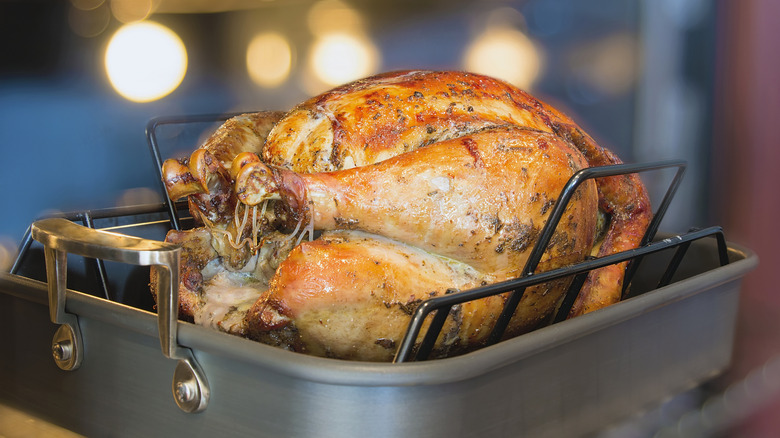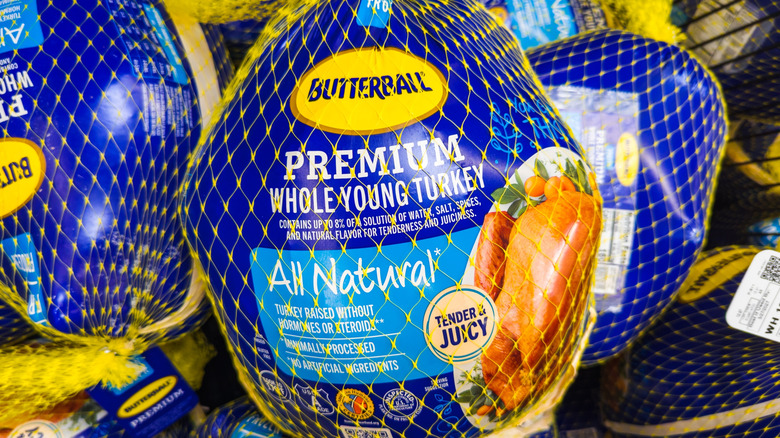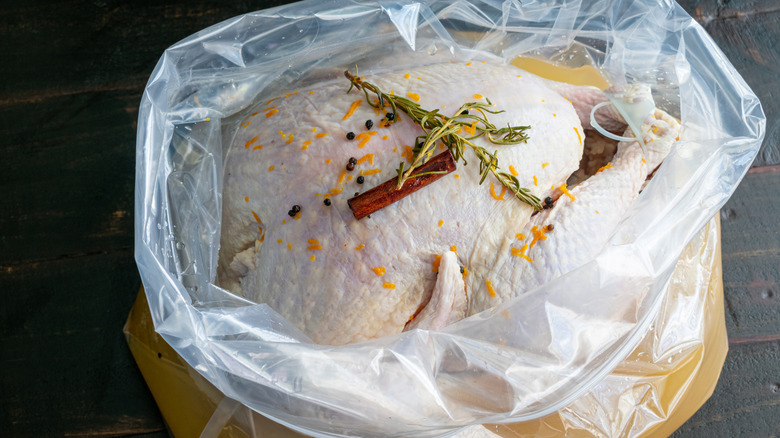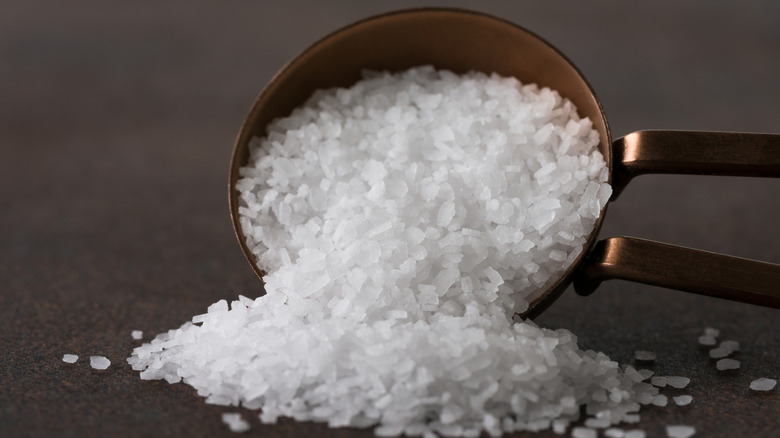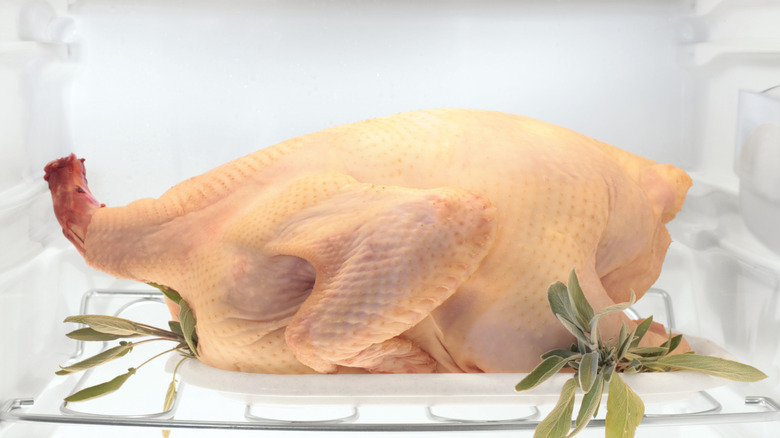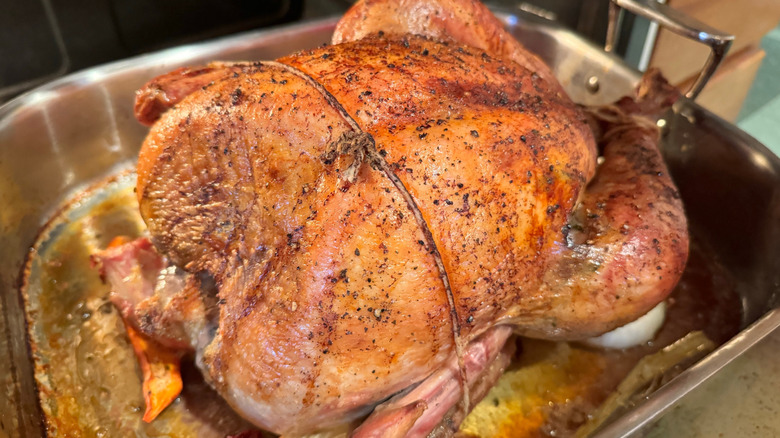8 Turkey Brining Mistakes You May Be Making
Confession: I sometimes skip adding turkey to my plate on Thanksgiving. I have excellent chefs in my family, but sometimes not even copious amounts of gravy can make up for a crumbly, flavorless bite of turkey.
One of the most basic Thanksgiving dinner hacks to help avoid this holiday faux pas is brining your turkey. In fact, chefs like Alton Brown say it's the one step you shouldn't skip in the leadup to cooking your Thanksgiving meal. Brining is most often associated with a wet brine, which involves soaking the whole bird in a solution of salty water. The salt content in the brine will loosen up the muscles within the lean turkey — and most poultry, in fact — and allows the bird to retain more water content as it cooks.
If your turkeys historically turn out dry and flavorless instead of becoming the glistening, succulent centerpieces you think they should be, it's possible you might be making a mistake in the brining process. Here are a few pitfalls to avoid to ensure you end up a turkey-prepping hero in the kitchen.
1. Brining a pre-brined turkey
You scoff, but the fact that this advice bears mentioning is proof enough that brining a pre-brined turkey has happened to more than a few unfortunate souls. If you brine a pre-brined turkey, chances are the end result will be overly salty protein.
One of the reasons it can be easy to purchase a pre-brined turkey without realizing it is because the labeling varies. Some brands might refer to brined turkeys as "basted" or "self-basted," which is labeling required by the USDA if brands add anything to the turkey besides the water bath that's used for processing them. Pre-brined turkeys can also be referred to as "enhanced," and poultry labeled "kosher" has already been salted on the outside and inside the body cavity.
Since brining a turkey helps it to retain moisture, turkey manufacturers like pre-brining the birds, because the turkey they sell you can weigh more after the brining process. Butterball is known for pre-brining its turkeys, for example. In other words, don't skip looking at your labels carefully. Unless you're somehow getting a free turkey this Thanksgiving, you don't want to pay extra for some added salt water.
2. Using the wrong container for brining
You don't want anything messing with the flavor of your turkey — except to maybe enhance it with salt and seasonings you're choosing yourself. But when you add salt to your brine, it can create a metallic taste that affects the cooked poultry if you let everything marinate in the wrong container.
Avoid using containers made from aluminum for this very reason. The aluminum will interact with the salt in the brine and lead to a metallic taste that will be memorable for all the wrong reasons. Most repeat Thanksgiving cooks say they used an oversized plastic container for the brining process: Some home chefs on Reddit say they splurged for The Briner bucket, which holds up to a 25-pound turkey in brine without allowing it to float outside of the liquid. The total cost for the bucket and shipping will run you about $50, which could be worth it to you if you use it every year. Others say they go a much cheaper route and use a 5-gallon Home Depot bucket, which is about $6 for the bucket and lid. (Home Depot is quick to point out that these buckets are not considered food safe, however, so you might want to buy some liners if you plan to go this route.)
3. Not accounting for enough space to brine your turkey
You might have your brining bucket — but do you have a way to keep that bucket and everything inside of it cool? Food safety is key when brining a turkey, and the USDA advises that the liquid brine and the turkey itself should always remain at 40 degrees Fahrenheit or cooler to avoid the potential for foodborne illness.
The best way to do this is to make some major room in your refrigerator, since it's already set up to keep everything at the right temperature. But creating that much space in your fridge the week of Thanksgiving might be a challenge. If that's the case, some people get creative with their brining locations. We've seen one suggestion to use your refrigerator drawer — with or without a brining bag. You can decide if that feels too experimental or not.
The more common secondary location for brining is in a cooler, which eliminates the need for any dedicated refrigerator space. As long as you've got a few bags of ice and a food-safe bag for the turkey and brine, you're set. America's Test Kitchen suggests making sure that the (thawed) turkey and brine are already cool, so that the ice in the cooler goes toward keeping the cooler itself at that desired 40 degrees or less. In their tests, 15 pounds of ice was enough to keep a 20-pound turkey in brine cold for more than 12 hours.
4. Using the wrong salt-to-water ratio for the brine
There really can be too much of a good thing when it comes to making a brine — or not enough. If you don't add enough salt, you're basically just soaking your turkey in water, which will make it tricky to crisp the skin without any added benefit of having a juicy, flavorful interior. But if you add too much, you and your guests will be gulping down glasses of water at the table.
According to the BBQ Pro Shop, you should mix 1 cup of kosher salt to 1 gallon of water for your wet brine. And yes, the type of salt does matter, since there is a real difference between kosher salt and table salt. Kosher salt has bigger grains, and the flat, flaky crystals dissolve in water very easily. Instead of making the water a tad cloudy like table salt can, the kosher salt also helps to retain a clear brining liquid.
More importantly, adding the same amount of table salt in a recipe that calls for kosher salt would likely make the final dish too salty, since the smaller grains allow for more sodium per cup. If you find yourself in a pinch and only have table salt when you're ready to make your brine, it's easier than you might expect to substitute it for kosher salt: Most sources recommend using half the amount of table salt compared to kosher salt, and then adjusting for taste after cooking.
5. Brining for the wrong amount of time
Just like balancing the salt content can be tricky in a brine, deciding how long to let your turkey hang out in a saltwater bath also takes some planning. Most people usually don't allow the turkey to soak in the brine for long enough. If you don't give it enough time, the salt can't penetrate the protein to allow for the bird to have enhanced flavor and retain its juices when cooking. You should allow the turkey to brine for around one hour per pound, but in general you should plan for the brining to take 12 to 24 hours.
If for some reason you don't get a chance to do the optimal amount of brining, even 15 minutes per pound of turkey can make a difference. The brine might not reach the center of your bird if it's on the larger side, but it will be juicier than if you hadn't brined at all.
It is possible to brine your turkey for too long, however, which could make the turkey too salty. It can also make the texture of the meat mushy or rubbery. Though you can't do much to change the texture at that point, you can rinse the bird (which isn't normally recommended) and soak it in fresh water for up to an hour to allow some of the salt to flow out of the turkey.
6. Not letting the turkey dry out for crispy skin
If you're not enjoying crisp, roasted turkey skin along with succulent white meat and drumsticks, what is even the point of cooking a whole turkey? But if you take your turkey straight from a brine into the oven, you'll likely struggle to get a golden color and crisp exterior.
Sources conflict about whether or not you should rinse your turkey after it comes out of the brine. BBQ Pro Shop suggests that rinsing it will ensure it doesn't taste too salty, but other recipe sites say rinsing it isn't necessary. The USDA advises against it in most cases, since washing raw poultry allows for easy cross-contamination around your sink area.
Regardless of whether you rinse it or not, several pros suggest allowing the turkey to air dry, uncovered, in your refrigerator for up to another 24 hours. This drying process won't dry out the meat inside, since the salt brine helped it to retain moisture. It will, however, allow the skin itself to dry out, which will help it crisp better when it's roasting in the oven.
7. Brining in cider or other acidic marinades
I made the mistake once of marinating chicken breasts in a mixture that included lime juice. The results were not the punchy lime flavor I expected: Instead, the chicken became dry and wrinkly before it even hit the grill. The reason this happens with acidic marinades and any poultry is because acid effectively begins to "cook" the proteins without heat. It's the same process that makes Mexican ceviche recipes delicious, but it's not a good method for your whole turkey.
That said, while you might want to get creative with your brine and add things besides water and salt, plan to avoid vinegars, ciders, and citrus in the brine itself. If you're using another liquid to impart flavor in the brine, you should keep that portion to ⅓ or less of the total liquid content, while keeping the brine at least ⅔ water.
Elevating your turkey brine with unique ingredients can be a great way to ensure the turkey stays the star of the show, instead of taking a backseat to the mashed potatoes or stuffing. If you choose to keep things simple with the brine, however, you can also impart loads of flavor with a dry spice rub. Or, you could choose to smoke your turkey instead of roasting it, which can add another layer of complex flavor.
8. Not attempting a dry brine at least once
The debate about whether to wet brine or dry brine a turkey is ongoing, and fans of dry brining say you're missing out if you don't give the method a try. For one, you don't need to worry about keeping a wet brine cool for an entire day.
A dry brine works by coating the skin of the turkey with salt (and other spices if desired) and allowing it to marinate for at least 12 to 24 hours, uncovered, in the refrigerator. You can put the turkey directly into the oven to roast from there, without needing extra time to dry the skin. A dry brine can also help the turkey to retain its natural juices while roasting, without diluting those flavors with the added water from a wet brine.
Salt mixed with some baking powder also allows the skin to become mouthwateringly crunchy. Try mixing a ½ cup of kosher salt with 2 tablespoons of baking powder, pat the thawed turkey dry with paper towels, then sprinkle the salt mixture over the entire bird. You will most likely not need all of the mixture since the turkey only needs a nice layer of salt on it without being totally encrusted. If you'd like to make a more aromatic mixture, we've tweaked Alton Brown's roast turkey recipe into one with a savory dry brine instead.
